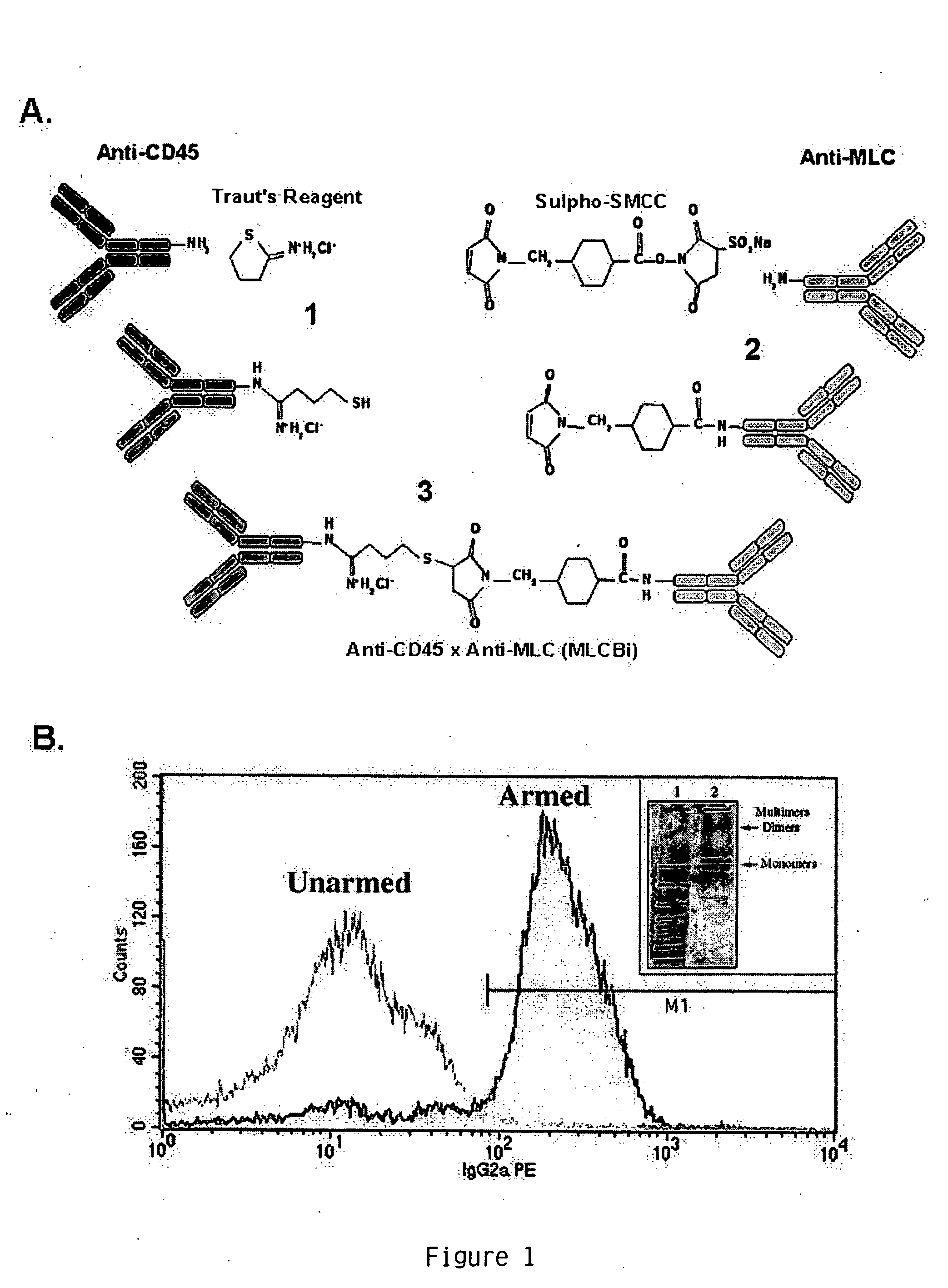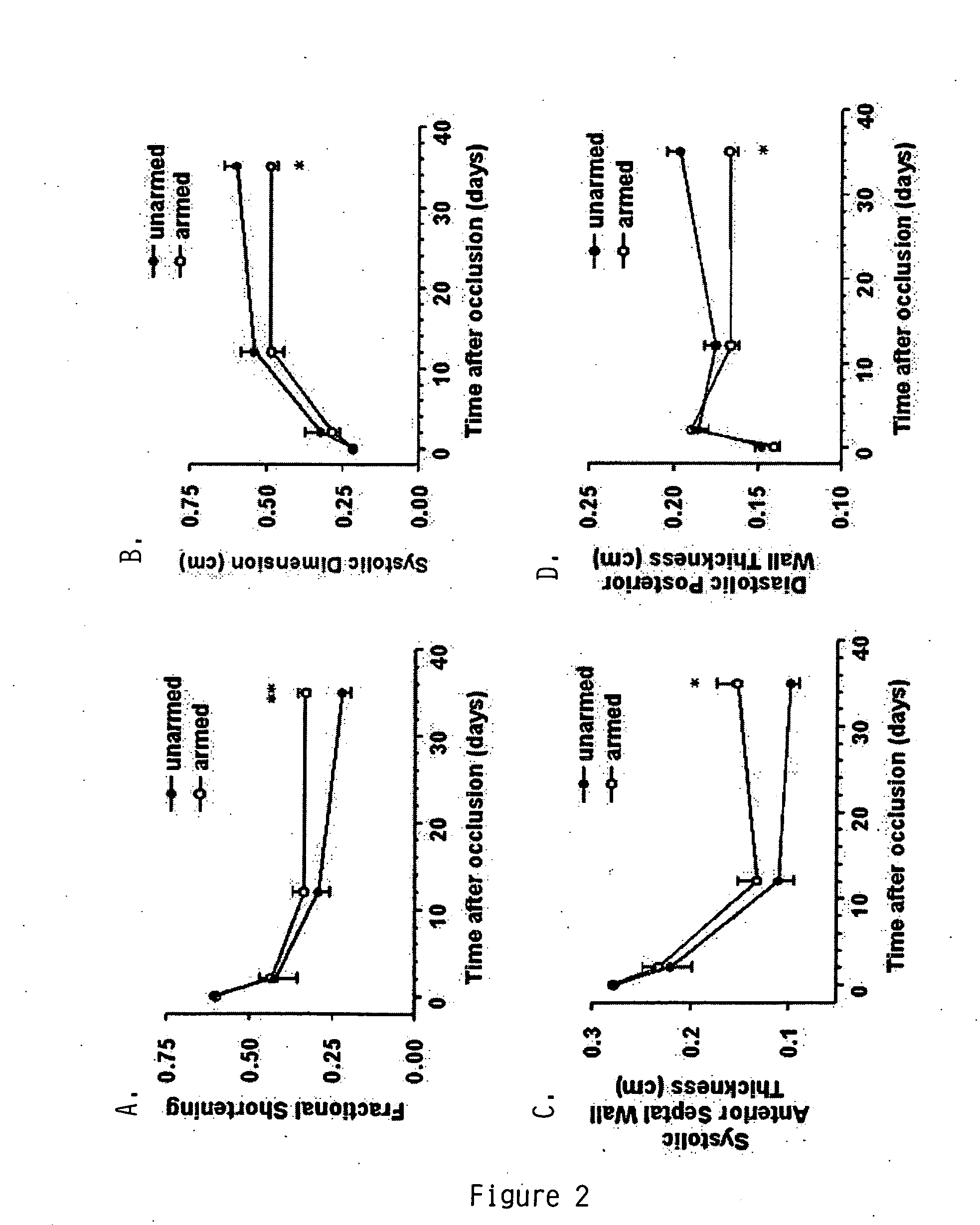Bispecific antibodies
- Summary
- Abstract
- Description
- Claims
- Application Information
AI Technical Summary
Problems solved by technology
Method used
Image
Examples
example 1
Materials and Methods
[0071] Conjugation and Analysis of anti-CD45× anti-MLC BiAb: An anti-myosin LC (“anti-MLC”) monoclonal antibody and an anti-CD45 monoclonal antibody (“anti-CD45”) were generated using methods known the in the art (see, e.g. Harlow and Lane, supra). The anti-MLC antibody was heteroconjugated to the anti-CD45 antibody to produce a bispecific antibody (“BiAb”), anti-CD45× anti-MLC (FIG. 1). Briefly, anti-CD45 (1-5 mg) in 50 mM NaCl, 1 mM EDTA, pH 8.0 was reacted with a 5-10 fold M excess of Traut's reagent (2-iminothiolane HCl, Pierce) and anti-MLC (1-5 mg) in 0.1 M sodium phosphate, 0.15 M NaCl at pH 7.2 was reacted with a 4-fold molar excess of sulphosuccinimidyl 4-(N-maleimidomethyl) cyclohexane-1-carboxylate (Sulpho-SMCC) at room temperature for 1 hr. Both antibodies were then purified on PD-10 columns in PBS to remove unbound cross-linker. The cross-linked mAbs were mixed immediately at equimolar ratios and conjugated at 4° C. overnight.
[0072] Anti-human CD4...
example 2
Targeted G-CSF Primed PBMC Specifically Localize to Infarcted Regions of Rat Myocardium
[0081] The BiAb anti-CD45× anti-MLC (CD45×MLC) was produced by chemical heteroconjugation as shown in FIG. 1A and as described in the methods (Sen et al., Journal of Hematotherapy &Stem Cell Research, 10:247-260 (2001)). The typical preparation consists of 12% conjugated dimers, 66% unconjugated monomers, and 22% multimers, as shown by Western blot (FIG. 1B, inset). Binding of the BiAb to PBMC via its anti-CD45 moiety was demonstrated using a goat anti-mouse IgG2a PE-conjugated antibody that recognized the mouse IgG2a anti-MLC arm of the BiAb. Cryopreserved GCSF primed PBSC were thawed, armed with 50 ng of anti-CD45× anti-rat anti-myosin LC per million PBSC (FIG. 1B shows the results of flow cytometric analyses of a sample from the PBSC either armed or unarmed with anti-CD45× anti-myosin LC), and injected intravenously into rats 48 hrs after transient ligation of the LAD artery.
[0082] The abilit...
example 3
Arming with CD45×MLC Enhances Homing and Persistence of Human G-CSF Primed PBMC at the Site of Myocardial Infarctions
[0083] Cryopreserved G-CSF primed PBMC were thawed, armed with 50 ng of bispecific antihuman CD45× anti-rat myosin light chain (MLC) antibody per million PBMC, and injected (8×106 cells) intravenously into nude rats 48 hrs after 17 minute ligation of the LAD artery followed by reperfusion. Rats were euthanized 5 weeks after cellular treatment and hearts were snap-frozen, sectioned and fixed with paraformaldehyde. Numerous human cells were detected in cardiac tissue at the site of infarction following immunohistochemical staining according to the manufacturer's instructions using the Animal Research Kit (ARK; DakoCytomation, Carpinteria, Calif.) combined with tyramide amplification (Dako CSA System) following high pH Target Retrieval and endogenous peroxidase quenching (DakoCytomation). Anti-HLA-DR (1.5μ / ml) and anti-HLA-A,B,C (3 P / ml) (BD Biosciences) were reacted wi...
PUM
 Login to View More
Login to View More Abstract
Description
Claims
Application Information
 Login to View More
Login to View More - R&D
- Intellectual Property
- Life Sciences
- Materials
- Tech Scout
- Unparalleled Data Quality
- Higher Quality Content
- 60% Fewer Hallucinations
Browse by: Latest US Patents, China's latest patents, Technical Efficacy Thesaurus, Application Domain, Technology Topic, Popular Technical Reports.
© 2025 PatSnap. All rights reserved.Legal|Privacy policy|Modern Slavery Act Transparency Statement|Sitemap|About US| Contact US: help@patsnap.com


